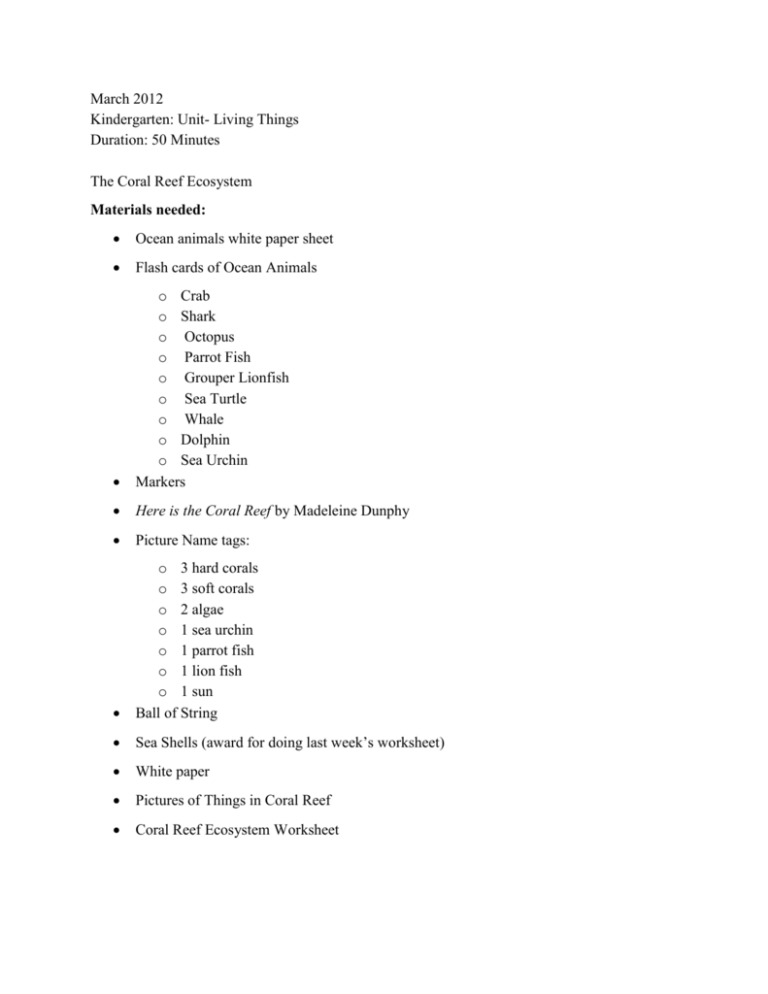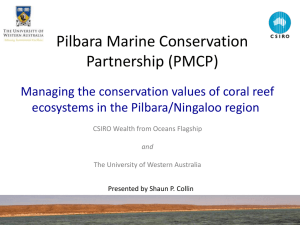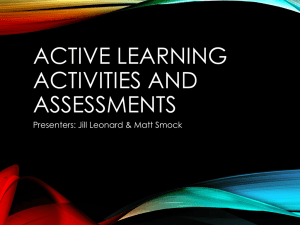March 2012 Kindergarten: Unit- Living Things Duration: 50 Minutes
advertisement

March 2012 Kindergarten: Unit- Living Things Duration: 50 Minutes The Coral Reef Ecosystem Materials needed: Ocean animals white paper sheet Flash cards of Ocean Animals o Crab o Shark o Octopus o Parrot Fish o Grouper Lionfish o Sea Turtle o Whale o Dolphin o Sea Urchin Markers Here is the Coral Reef by Madeleine Dunphy Picture Name tags: o 3 hard corals o 3 soft corals o 2 algae o 1 sea urchin o 1 parrot fish o 1 lion fish o 1 sun Ball of String Sea Shells (award for doing last week’s worksheet) White paper Pictures of Things in Coral Reef Coral Reef Ecosystem Worksheet Resources: http://www.earthwatch.org/downloads/lessons/Interdependancy_of_Coral_Reefs.pdf Teacher Preparation Write learning goal on board Hang up Ocean Animals white paper sheet Organize picture name tags Put sea shells in yellow folders of students who did the ocean animals worksheet Assign student to hand out coral reef ecosystem worksheet Objective: Students will discuss the coral reef ecosystem by reenacting in their own. Procedures: Opening (6 minutes): I. “Good afternoon class! How are you? (A: Good, How are you?). I am good. I would like everyone to come to the carpet in rows.” Allow student to come the carpet in rows. “Great thank you very much. Now let us all read the learning goal together, ‘ the learning goal is to discuss the coral reef ecosystem by reenacting their own” Great job everyone. Great so who can raise their hand and in one sentence tell me what we did last week (A: Last week we made oceans, last week we studied ocean animals). Great so last week we talked about ocean animals, animals that live in oceans. Now within oceans ocean animals interact with each other and non living things. These interactions are important because it allows ocean animals to survive in the ocean. The areas or communities where ocean animals and non-living things interact are called ecosystems. Because it is such a huge body of water, an ocean has many different ecosystems. Today we are going to be talking about the coral reef ecosystem, a ocean community where several of the ocean animals we talked about last week live and interact with non-living things.” Review Ocean Animals: “Now before we start our lesson let us review what animals live in the ocean. Please face the white board. I am going to give you a minute with your neighbor to think of two ocean animals we put in our oceans.” Allow students 1 minute to think of two ocean animals. “Did everyone think of one? Great. Student, what was one animal you and your neighbor remembered? (A: Crab, Shark, Octopus, Parrot Fish, Lionfish, Sea Turtle, Whale, Dolphin, Sea Urchin).” While students are answering write their responses on Ocean Animals white paper sheet and paste flashcard of ocean animal. “Great now one animal we could add to this list is coral, a distant relative to jellyfish that live and play an important role the coral reef ecosystem.” Sea Shells: Give students sea shells for doing ocean animal worksheet last week. Activity (37 minutes): II. Read Here is the Coral Reef (2 minutes): “To begin our lesson we are going to be reading Here is the coral Reef” Discuss Here is The Coral Reef (5 minutes): o What ocean animals did you see in the coral reef? o Coral Reef Reenactment Directions (10 minutes): “Great discussion everyone! Now based on the interactions between ocean animals, non-living things we are going to reenact our own coral reef ecosystem! In our reenactment of our coral reef ecosystem we have 7 characters: hard corals, soft corals, algae, sea urchin, parrot fish, grouper lion fish, and sun. Before we begin our reenactment I need all of you to decide which character you would like to play. Take a minute and think about which character you want to play. When you have decided sit quietly.” Give students a minute to decide what character they want to play. “Did everyone think of a character they wanted to play? Great. So you are interested in playing a coral raise your hand and I will give you a name tag.” Select 4 people to play coral. “You two will be hard corals and you two will be soft corals.” Give kids coral name tags. “Corals I want you to quietly stand left of me. Now students based on what you know about corals, when you are reenacting a coral what movement or hand gesture could you do to make sure we know who you are reenacting? (A: make little circles little polyps with your hands). Great now raise your hand if you want to be algae (otherwise known as seaweed)?” Chose two students to be algae and give them name tags. “Algae I want you to quietly stand right of me. Now students based on what you know about algae, when you are reenacting algae what movement or hand gesture could you do to make sure we know who you are reenacting? (A: move one arm back in forth like algae floating in water). Good idea. Now raise your hand if you want to be a sea urchin?” Select one student to be a sea urchin and give him/her a name tag. “Please stand with the algae. Now students based on what you know about sea urchins, when you are reenacting a sea urchin what movement or hand gesture could you do to make sure we know who you are reenacting? (A: spread your arms out and stick out your fingers like the spikes on a sea urchin). Great. Now raise your hand if you want to be a parrot fish or a grouper lion fish.” Chose one student to be a parrot fish and one to be a grouper lion fish and give them name tags. “Fish please stand in the back left corner. Now students based on what you know about parrot fish, when you are reenacting a parrot fish what movement or hand gesture could you do to make sure we know who you are reenacting? (A: put your hands on your mouth like a beak of a parrot fish). Great. So students based on what you know about grouper lion fish when you are reenacting a grouper lion fish what movement or hand gesture could you do to make sure we know who you are reenacting? (A: put spikes on your back). Now I need your three to be the people in the sun.” Chose one student to be the sun and give them name tag. “Sun please stand in the back right corner. Now students based on what you know about the sun, when you are reenacting the sun what movement or hand gesture could you do to make sure we know who you are reenacting? (A: use your arms to make a circle on your head just like a sun). Now does everyone remember their hand gesture?” Ask one student from each group to make a hand gesture. “Great job everyone. We are almost ready to do our reenactment!” Move to circle with yarn. Now while you reenact your characters in the coral reef I will be narrating the story. Based on when I mention your characters name you will stand in the middle of the carpet and take or be passed the ball of yarn. You will then take a piece of the yarn and when the narrative says so pass the ball of yarn the next character while still holding onto your string. That way all the characters will be linked and interacting with each other, just a real coral reef ecosystem! This will show how all these ocean animals and non-living things interact with one another. The key to this activity is to pay attention to what I am saying. Is everyone ready?. Great! lets begin.” Reenact Coral Reef system (10 minutes): “On the rocks near ocean shore, hard corals have begun to form. There are many kinds of coral: brain corals, fire corals, mustard hill corals, mountainous star corals, and many more. Their tiny polyps open to catch food that drifts by in the water but they can’t move off the reef. Their skeletons build the reef like adding bricks to a wall.” Give the hard corals come to the center and give them the ball of string “Near by are soft corals swaying in the current. They stay attached to rocks but they don’t build the reef. They also have tiny polyps for eating food drifting by, and they make nice hiding places for small fish.” Have the hard corals toss the ball of string to the soft corals, spooling out a length of the string and hanging on to the end. Toss the ball of string to the fish that hide among them, and they toss it back. “Growing on the rock and on the coral are plants called algae. They can be soft and green like moss or crunchy like little tiny branches or flat and crusty. They need sunlight to grow. They can cover up a little bit of the coral or a lot of the coral, depending on the water temperature and how much of them gets eaten by fish or urchins.” Have the soft corals toss the ball of string the algae, who toss it back to the hard corals, so they are all webbed together. “The long-spined urchins find places to sit in the coral reef. The spines are sharp and can protect the urchin from predators that might want to eat it. It eats algae off the reef.” Have the hard corals toss the ball of string to the sea urchins, who hold the string and toss the ball back to the algae “Swimming along near the hard and soft corals are different kinds of fish. There are parrot fish that nibble on the corals and the algae that grow there.” Have the algae toss the ball of string to each of the fish and they each hold on and toss the ball back to the algae “There is also one lion fish that came all the way from a far-away ocean. It didn’t always live in the coral reef, but has come here recently. Its spiky fins are very poisonous to people and to other fish. It holds very still so it looks like seaweed and waves its spiky fins to try to sting passing fish to kill them.” Have the Fish toss the ball of string to the lion fish “The sun shines on the ocean, giving light to make the algae grow and the coral polyps grow.” Have lion fish pass ball to sun and have sun pass ball of string to algae. Have algae pass ball of string to sun and have sun pass ball of string to soft coral and hard coral. Reenactment Discussion (10 minutes):“Great job every one. Now staying in your spots lets discuss the coral reef ecosystem even more. Keep holding onto your string.” o “Now what happens if the fish eat the algae? (A: the algae feel a tug). Yes, the algae will feel a tug. When the fish and algae interaction is in balance (i.e. the algae grow just as much as the fish eats it) the algae grow food for the fish and the fish eat enough algae to keep the coral healthy.” o “What happens if the lion fish kills some of the parrot fish? (A: parrot fish feels a tug)?” o “What happens to the algae if fewer parrot fish are nibbling on it? (A: algae will tug on coral). Yes if not enough fish are eating the algae too much algae will grow on coral can cut off sunlight to the coral and make it sick.” o “If the coral does not get enough sunlight, it can get sick and die. This causes pieces of coral die and break off. Which organisms does it affect? (A: algae, fish, sea urchins). Correct if coral dies, it will affect algae. Algae will be unable to grow and make food for fish and sea urchins. Fish will not have enough food to be healthy. And Sea urchins will not have a place to live.” o “Which thing in the reef does the sun affect? (A: lion fish, algae, corals) Correct, the sun affects the lion fish, algae and coral. If things are in balance, the sun helps algae and other plants and coral grow and gives light to the fish.” “Now you can see overall how these interactions between ocean animals and non-living things are very important for ocean animals’ survival. Great Job today everyone! You can return to your assigned seats.” SPONGE: Coral Reef Ecosystem Mural: Assign students different non-living or living things found in the coral reef ecosystem to color in and glue on the big white sheet of paper. III. Closing/Wrap Up: Coral Reef Ecosystem Worksheet: “Student, will you please hand out the Coral Reef Ecosystem Worksheet?” Allow student to hand out Coral Reef Ecosystem Worksheet. “Did everyone get one? Great. Now students with the rest of the class period on the top two boxes I would like you to draw two living things you saw in the coral reef ecosystem and the bottom two boxes two non-living things. When you are done you can return your sheet to your yellow folder. If you do not finish you can also put your worksheet in your yellow folder and finish at home.” Student Assessment: Students ability to participate Students ability follow directions Students ability to listen to narrative








